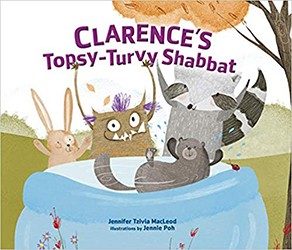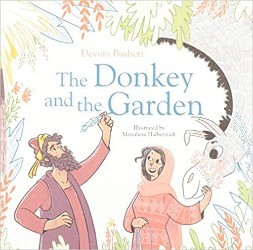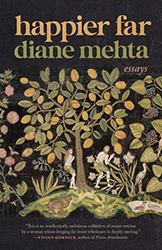In the great green room, there was, instead of a telephone and red balloon, a Jewish family about to celebrate Hanukkah. Although there have been other parodies, ranging from witty to rude, this one is a decidedly “joyful” exercise in yiddishkeit, starring an extended family of rabbits with human, and Jewish, qualities. The book’s subtitle is entirely accurate. This is not meant to be an original story; it is certainly humorous and the author’s intention is not mockery but rather an endearing homage to a beloved classic. Children will have the opportunity to learn some Yiddish, and adults will likely kvell over the appearance of menorahs in the window of that famously calm and reassuring bedroom where generations of children have been lulled to sleep.
Sheryl Haft and Jill Weber echo some of the motifs of Margaret Wise Brown and Clement Hurd’s Goodnight Moon without irony. The original rabbit’s striped sleeper here is red, with white snowflakes or flowers. The portrait of the three bears is a rabbit family and the young rabbit’s transitional object has become a toy gorilla. The text, however, has changed significantly, from an almost existential quiet, to a party so exciting that it’s a wonder any child could fall asleep at its conclusion. The rhymes offer an opportunity to introduce every familiar Yiddish phrase that comes to mind; if readers do not expect subtlety, they will not be disappointed. There is no competition between the “two little bubbies schlepping their hubbies,” and all of the mishpacha who are happily “noshing on latkes.” In addition to the main narrative, characters add their own contributions in word bubbles: “Eat, eat, my little bubbala” and “So good I could plotz” are typical examples. (If you were wondering about that toy gorilla, it does rhyme with “the whole megillah.”)
What elevates this story above the level of simplistic satire? While the answer to that question lies in the eyes of the beholder, one answer is the occasional departure from the expected. “Goodnight menorah/Goodnight, flute/And goodnight to old Zeyde, asleep in his suit” captures the moment when the party is over and the realistically old grandfather is ready to call it a day. Weber’s pictures are funny, but also tender. Zeyde folds himself into a bright red chair, his grey. striped suit matching the silver tabby cat asleep on his lap. There is a bit of Chagall in his dreaming face and his extended body is in a relaxed posture. Other pages offer alternative objects to the original book’s bears, chairs, and bowl of mush. Such reliably Jewish items as “one dozen bagels” and “a pot of kneidels” are simple, brightly colored, and modestly arranged against a spare background, offering a visual respite from the raucous party scenes. One lovely image leaves the realm of parody to present a small tribute to reading, including copies of Pat the Bunny, The Tale of Peter Rabbit, and other literary touchstones of childhood. Like the bowl of soup pictured, Goodnight Bubbala is a good blend of ingredients for families.
Goodnight Bubbala is recommended for young children and their caregivers. It includes a glossary of Yiddish phrases, an author’s note, and a recipe for latkes, written by noted cookbook author Ina Garten.
Emily Schneider writes about literature, feminism, and culture for Tablet, The Forward, The Horn Book, and other publications, and writes about children’s books on her blog. She has a Ph.D. in Romance Languages and Literatures.




